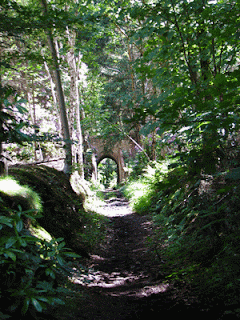Many of the buildings he created used the bricks from the Ockham Brickworks and he had decorative details incorporated into the buildings made from his and his wife’s family crests. His forests provided timber for the brickworks and in order to get the timber to the works, William had fifteen horseshoe shaped bridges constructed across the valleys in the woods. These spans range from six to eighteen feet, and now there are only ten remaining with their distinctive red brick and flint style. We hoped to see as many as possible, but only later realized that five are able to be seen by the public; five are in private estates; and of the other five there are barely remains to be seen.
We parked in the Green Dene car park, and with our Trail map in hand, crossed the road to the path that joins the bridges together. This trail is signposted by The Horsley Countryside Preservation Society, but you need to be very observant as there are lots of trails and bridleways that could lead you astray.



Our first sighting was the site of Falcon Arch at the edge of the uniquely named lane, Honeysuckle Bottom. Then we headed up hill, coming across Raven Arch, a little of the forest track we were following. As we walked under this arch, we followed the trail up and up and wondered if we were on the right track, only to be rewarded with the view of Briary Hill West and then BH East quite close by. Further along the trail we came across several remains before reaching Stony Dene Bridge. This is the first bridge to be renovated by The Horsley Countryside Preservation Society, and work is ongoing. It is a splendid sight and really shows the outstanding work of William, Lord Lovelace all those years ago. From here we made a circuitous route to find the Dorking Arch, which is an eighteen foot span across a main road known as Crocknorth Road. This bridge has decorative arrow slits built into the parapet and is a huge surprise after the other smaller bridges. This marked the last of our bridge sightings and we followed the forestry road back down passing Raven Arch and the site of Falcon Arch to our car at Green Dene, again.
It was a very interesting walk, which was also full of the wildlife of the forest, including a fleeting glimpse of a deer, many birds, flowers and butterflies.






























